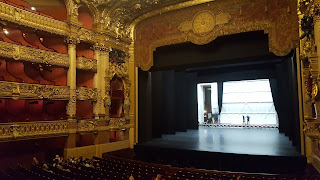The most significant site we visited, which we intentionally skipped in March, was the Louvre Museum. The Louvre is truly overwhelming, It is the world's largest art museum and contains approximately 38,000 pieces of art displayed over almost 800,000 square feet (over 14.5 football fields). Of course, we visited the three most famous pieces of art in the museum: The Mona Lisa, Venus de Milo, and Winged Victory, along with many others. But, we spent a lot of our time on the lower levels of the museum learning about the history of the building.
The Louvre was originally built as a fortress by Phillip II in the late 12th century. An excavation in the 1980's and 1990's discovered the retaining walls from that period. Now, you can walk in an area that was the fortresses's moat over 800 years ago, and see some of those original walls:
Nearby exhibits then take you through the history of how the Louvre went from a fortress to a palace to a museum. The Louvre was the primary residence of the French Kings from the mid-16th century until Louis XIV completed the Palace at Versailles and made it his primary residence in 1682. Then, soon after the French Revolution, it was decided to make the Louvre a museum. It opened in 1793 with an exhibition of about 600 paintings. Although it has obviously undergone a great many modifications since then, it has remained a museum for 225 years. We really enjoyed this exhibit.
Near the Louvre, at the Palais Royal metro station is a funky sculpture that Jeff thinks looks like the French crown found in the Louvre but actually is a sculpture titled the "Kiosk of the Night Owls" erected to celebrate the centenary of the Paris metro in 2000. This stop was one of the original eight stations opened in 1900:
The Paris Opera House (Palais Garnier), which opened in 1875, is a spectacular building that still hosts performances of opera and ballet:
The current ceiling of the performance hall was painted by Marc Chagall and installed in 1964:
There was even an exhibit about the inspiration and influence of dance on Pablo Picasso who, much to our surprise, was involved in creating sets and costumes for several operas in Paris in the early 20th century. Very interesting!
The Paris Catacombs were also fascinating, if a bit more macabre. The full history of the catacombs goes back over 2000 years to the Roman period. In those days, Lutetian limestone was mined near the Roman city of Lutetia (where Paris is today) from open mines at the surface. In the 12th century, the rock was mined by digging wells, extracting it and, once exhausted, simply closing up the quarries.
Unfortunately, as Paris expanded, the city was built over these forgotten quarries and, in 1774, a series of collapses had whole city blocks falling through the earth into the unsupported mines below. After much agitation, Louis XVI - remember, this was before the Revolution - began a process of reinforcing the mines. At the same time, Paris's cemeteries were becoming too full. So, the city began moving the bones from cemeteries, which were now within the city down to the reinforced mines. This process continued off-and-on over the years. Now, the tunnels contain the bones of over six million people. And, you can visit a small part of this truly creepy place:
Yes, those are human bones. Mostly what you see are femurs and skulls. Smaller bones are behind those and out of sight, but the femurs and skulls are stacked floor to ceiling for miles. The tour itself takes you through a passage about one mile long, but that barely scratches the surface of the tens (hundreds?) of millions of bones that are there. Weird, but surprisingly interesting.
Well, we now find ourselves in The Great White North (aka Canada). More posts from there soon, eh.
Jeff and Shana








No comments:
Post a Comment